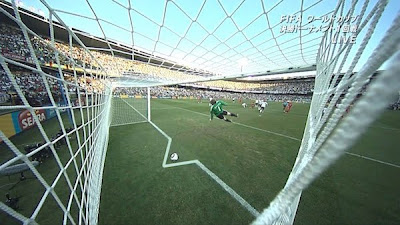
The recent wave of 3D has been all about action and spectacle, taking us from Tim Burton's Wonderland to James Cameron's Pandora. Today I had a much different three-dimensional experience, one that was subtle and extremely promising: the World Cup. Whether we like it or not, 3D is happening. At this point, most blockbuster movies are offering a third dimension of themselves to viewers, and 3DTVs, Blu-ray players, andgaming consoles mean that soon you'll have to decide just how high-tech you want your home theater to be. While 3D has proven adequate, and even, a lot of the time, very awesome for experiencing big-budget movies at home, one 3D question mark has been the timeless man cave standby of sports. If the World Cup broadcast I saw is anything to go by, they too can gain a lot from a little 3D magic. The game I watched, hosted by Sony and ESPN, was among the least demanding 3D experiences I've had—and that's a good thing. I generally find 3D to be pretty taxing to watch, and I've been skeptical of the idea that someday in the not-so-distant future I'd be lounging on my couch enjoying a leisurely 3D experience. Today seemed different. Sure, I was still rocking bulky active shutter glasses the whole time, but finally the broadcasters had resisted the urge to make things jump out at me and let them fall into space behind the TV. It was smart 3D, not showy 3D, and that's an important distinction. From the standard soccer camera angle—viewing the pitch from a distance—things looked more or less like they do in 2D. There was some additional depth, and it looked fine, but it wouldn't necessarily sell you on 3D sports. When the cameras cut to a closer shot, however, and you were at eye-level with the players—there were more of these shots in the 3D broadcast than usual—the 3D was revelatory, offering a whole new perspective on World Cup action. Passing lanes opened up, tackles seemed like tackles, and you just generally got a sense of how much running players do, something that's sort of lost when you're watching them scurry around like ants on a well-manicured lawn. And, when they were shown, fan shots were especially fun 3D—something that's secondary to the game, maybe, but not the experience of watching the game at home. There were occasional technical hiccups—someone would block the sensor and the glasses would snap out of focus—but for the most part, the 3D tech just worked without drawing attention to itself. As they explained to me, ESPN has been doing their 3D "homework," testing how a huge variety of in-game situations look from a range of 3D camera angles in pretty much every major sport. Generally, the closer you are to the action, the more rewarding the 3D experience is, they said, and while the World Cup broadcast offered a few tantalizing glimpses of this promise, I can only imagine how immediate and immersive an NBA game would be in 3D. And you can bet that that's right around the corner. If 3D is going to make the jump from being a movie theater novelty to being a sensible home entertainment option, broadcasters are going to have to treat it sensibly. Watching the World Cup today, for the first time, I saw how that vision come into focus. [Sony 3D, ESPN 3D]





































